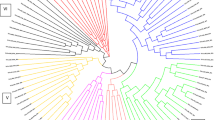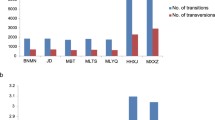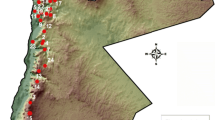Abstract
Dendrobium nobile Lindl. is one of the most important Orchid plants worldwide. The genotype-by-sequencing (GBS) method has now been widely used to access genetic diversity because of its high-throughput and cost-effective in molecular markers. The goal of this study was to employ the GBS technique for diversity evaluation of D. nobile and determine genetic differences between populations. A total of 129 accessions of D. nobile collected from 10 imitation-wild cultivated populations growing in Sichuan, Guizhou and Yunnan of southwestern China were sequenced, a total of 135 G clean reads and a total of 836,786 high quality SNPs were yielded and used for analysis of genetic diversity and population structure. The accessions of D. nobile were classified into three groups, excepts for 14 accessions belonging to admixed group. Genetic variation was greater within populations (87.80%) than among populations (12.20%). There was gene exchange between different populations. The 10 populations were classified into three groups, and group III could be further divided into two subgroups. The results will not only provide valuable information for the level of genetic diversity of D.nobile growing in southwestern of China, but also help for formulation of strategies for genetic resource protection and utilization. The accessions used in this study could be applied to the scientific research, breeding and production of D. nobile.





Similar content being viewed by others
References
Alexander DH, Novembre J, Lange K (2009) Fast model-based estimation of ancestry in unrelated individuals. Genome Res 19:1655–1664
Altschul SF, Gish W, Miller W, Myers EW, Lipman DJ (1990) Basic local alignment search tool. J Mol Biol 215:403–410
Bhattacharyya P, Kumaria S, Tandon P (2013) Start codon targeted (SCoT) marker reveals genetic diversity of Dendrobium nobile Lindl., an endangered medicinal orchid species. Gene 529:21–26. https://doi.org/10.1016/j.gene.2013.07.096
Bhattacharyya P, Kumaria S (2015) Molecular characterization of Dendrobium nobile Lindl., an endangered medicinal orchid, based on randomly amplified polymorphic DNA. Plant Syst Evol 301:201–210. https://doi.org/10.1007/s00606-014-1065-1
Bhattacharyya P, Kumaria S, Tandon P (2015b) Applicability of ISSR and DAMD markers for phyto-molecular characterization and association with some important biochemical traits of Dendrobium nobile, an endangered medicinal orchid. Phytochemistry 117:306–316. https://doi.org/10.1016/j.phytochem.2015.06.022
Carvalho LJCB, Schaal BA (2001) Assessing genetic diversity in the cassava (Manihot esculenta Crantz) germplasm collection in Brazil using PCR-based markers. Euphytica 120:133–142
Chen TQ, Huang F, Li WZ, Jiang XL, Wang W, Liu DC, Yang WL, Zhang AM, Zhang LY (2015) Investigation and analysis of genetic diversity and population structure for wheat germplasms resistant to stripe rust in southwest China. J Plant Genetic Resour 16(6):1157–1167. https://doi.org/10.13430/j.cnki.jpgr.2015.06.004
Chinese Pharmacopoeia Commission (2020) Pharmacopoeia of the People’s Republic of China, vol I. China Medical Science and Technology Press, Beijing, pp 94–97
Cui XQ, Tang X, Huang CY, Deng JL, Li XL, Lu JS, Zhang ZB (2021) Genetic diversity analysis and fingerprinting construction of Dendrobium germplasm resources by iPBS marker. Chin J Trop Crops 42(2):317–324. https://doi.org/10.3969/j.issn.1000-2561.2021.02.004
Danecek P, Auton A, Abecasis G et al (2011) The variant call format and VCFtools. Bioinformatics 27(15):2156–2158. https://doi.org/10.1093/bioinformatics/btr330
Doyle JJ, Doyle JL (1987) A rapid DNA isolation procedure for small quantities of fresh leaf tissue. Phytochemistry Bull 19(1):11–15
Ebbert MTW, Wadsworth ME, Staley LA et al (2016) Evaluating the necessity of PCR duplicate removal from next-generation sequencing data and a comparison of approaches. BMC Bioinformatics 17(Suppl 7:239):492–543. https://doi.org/10.1186/s12859-016-1097-3
Elshire RJ, Glaubitz JC, Sun Q et al (2011) A robust, simple genotyping-by-sequencing (GBS) approach for high diversity species. PLoS ONE 6(5):e19379. https://doi.org/10.1371/journal.pone.0019379
Excoffier L, Laval G, Schneider S (2005) Arlequin (version 3.0): An integrated software package for population genetics data analysis. Evolutionary Bioinfoamatics 1:47–50
Feng SG, Lu JJ, Gao L, Liu JJ, Wang HZ (2014) Molecular phylogeny analysis and species identification of Dendrobium (Orchidaceae) in China. Biochem Genet 52:127–136. https://doi.org/10.1007/s10528-013-9633-6
Feng SG, He RF, Yang S, Chen Z, Jiang MY, Lu JJ, Wang HZ (2015) Start codon targeted (SCoT) and target region amplification polymorphism (TRAP) for evaluating the genetic relationship of Dendrobium species. Gene 567:182–188. https://doi.org/10.1016/j.gene.2015.04.076
Garrison E, Marth G (2012) Haplotype-based variant detection from short-read sequencing. Quant Biology 20:1–9
He T, Fan XL, Lu L, Huang TF (2021) Phenotypic trait diversity of Dendrobium nobile from different provenances and their correlations with geographical factors. J Plant Resour Environ 30(2):1–11. https://doi.org/10.3969/j.issn.1674-7895.2021.02.01
Hoque A, Fiedler JD, Rahman (2020) Genetic diversity analysis of a flax (Linum usitatissimun L.) global collection. BMC Genomics 21:557. https://doi.org/10.1186/s12864-020-06922-2
Jiang AM, Cao J, Cai GL (2016) Genetic relationship of Dendrobium and genetic diversity of Dendrobium nobile in Qinling-Daba mountains revealed by ISSR. Acta Bot Boreali-Occidentalia Sinica 36(10):1977–1983. https://doi.org/10.7606/j.issn.1000-4025.2016.10.1977
Jiang JL, Ye W, Li YQ, Fan ZM, Lei FG, Zhang R, Zhou JJ (2016) Genetic relationships among wild Dendrobium officinale populations in Taining, Fujian by ISSR. J Trop Subtropical Bot 24(3):259–266. https://doi.org/10.11926/j.issn.1005-3395.2016.03.003
Kang JY, Lu JJ, Qiu S, Chen Z, Liu JJ, Wang HZ (2015) Dendrobium SSR markers play a good role in genetic diversity and phylogenetic analysis of Orchidaceae species. Sci Hort 183:160–166. https://doi.org/10.1016/j.scienta.2014.12.018
Li H, Durbin R (2009) Fast and accurate short read alignment with Burrows-Wheelers transform. Bioinformatics 25(14):1754–1760. https://doi.org/10.1093/bioinformatics/btp324
Lu JJ, Kang JY, Feng SG, Zhao HY, Liu JJ, Wang HZ (2013) Transferability of SSR markers derived from Dendrobium nobile expressed sequence tags (ESTs) and their utilization in Dendrobium phylogeny analysis. Sci Hort 158:8–15. https://doi.org/10.1016/j.scienta.2013.04.011
Ma JM, Yin SH (2009) Genetic diversity of Dendrobium fimbriatum (Orchidaceae), an endangered species, detected by inter-simple sequence repeat (ISSR). Acta Bot Yunnanica 31(1):35–41. https://doi.org/10.3724/SP.J.1143.2009.08076
Martin SH, Davey JW, Jiggins CD (2014) Evaluating the use of ABBA–BABA statistics to locate introgressed loci. Mol Biol Evol 32(1):244–257. https://doi.org/10.1093/molbev/msu269
Mousadik AE, Petit RJ (1996) High level of genetic differentiation for allelic richness among populations of the argan tree[Argania spinose (L.) Skeel] endemic to Morocco. Theor Appl Genet 92:832–839
Nguyen N-H, Vu H-T, Le N-D, Nguyen T-D, Duong H-X, Tran H-D (2020) Molecular identification and evaluation of the genetic diversity of Dendrobium species collected in Southern Vietnam. Biology 9:76. https://doi.org/10.3390/biology9040076
Niu SZ, Song QF, Koiwa H, Qiao DH, Zhao DG, Chen ZW, Liu X, Wen XP (2019) Genetic diversity, linkage disequilibrium, and population structure analysis of the tea plant (Camellia sinensis) from an origin center, Guizhou plateau, using genome-wide SNPs developed by genotyping-by-sequencing. BMC Plant Biol 19:328. https://doi.org/10.1186/s12870-019-1917-5
Pavan S, Marcotrigiano AR, Ciani E, Mazzeo R, Zonno V, Ruggieri V, Lotti C, Ricciardi L (2017) Genotyping-by-sequencing of a melon (Cucumis melo L.) germplasm collection from a secondary center of diversity highlights patterns of genetic variation and genomic features of different gene pools. BMC Genomics 18:59. https://doi.org/10.1186/s12864-016-3429-0
Perea C, Hoz JFDL, Cruz DF, Lobaton JD, Izquierdo P, Quintero JC, Raatz B, Duitama J (2016) Bioinformatic analysis of genotype by sequencing (GBS) data with NGSEP. BMC Genomics 17(Suppl 5,498):539–551. https://doi.org/10.1186/s12864-016-2827-7
Porras-Hurtado L, Ruiz Y, Santos C, Phillips C, Carracedo A, Lareu MV (2013) An overview of STRUCTURE: applications, parameter settings, and supporting software. Front Genet 4:98. https://doi.org/10.3389/fgene.2013.00098
Pritchard JK, Stephens M, Donnelly P (2000) Inference of population structure using multilocus genotype data. Genetics 155(2):945–959
Satya P, Karan M, Jana S, Mitra S, Sharma A, Karmakar PG, Ray DP (2015) Start codon targeted (SCoT) polymorphism reveals genetic diversity in wild and domesticated populations of ramie (Boehmeria nivea L. Gaudich.), a premium textile fiber producing species. Meta Gene 3:62–70. https://doi.org/10.1016/j.mgene.2015.01.003
Smith HO (1980) Recovery of DNA from gels. Methods Enzymol 65:371–380
Taranto F, D’Agostino N, Greco B, Cardi T, Tripodi P (2016) Genome-wide SNP discovery and population structure analysis in pepper (Capsicum annuum) using genotyping by sequencing. BMC Genomics 17:943. https://doi.org/10.1186/s12864-016-3297-7
Tsi ZH, Chen SC, Luo YB, Zhu GH (1999) Orchidaceae (3). In: Tsi ZH (ed) Angiospermae, Monocotyledoneae, Flora Reipublicae Popularis Sinicae. Science Press, Beijing, pp 111–113
Wang SS, Hou FX, Zhao JR, Cao J, Peng C, Wan DG, Guo JL (2018) Authentication of Chinese herbal medicines Dendrobium species and phylogenetic study based on nrDNA ITS sequence. Int J Agric Biology 20:369–374. https://doi.org/10.17957/IJAB/15.0500
Wang XK, Jiang D, Sun ZZ (2017) Study on phylogeny of 240 Mandarin accessions with genotyping-by-sequencing technology. Sci Agric Sin 50(9):1666–1673. https://doi.org/10.3864/j.issn.0578-1752.2017.09.012
Wright S (1978) In Evolution and the Genetics of Population 4: variability within and among national population. the university of Chicago Press, Chicago & London, pp157
Xie JK, Zuo JH, Huang YH, Li CS, Chen YL (2020) The origin and germplasm collection for cultivated Dendrobium officinale K. Kimura & Migo individuals revealed by EST-SSR markers. Genet Resour Crop Evol 67:1209–1219. https://doi.org/10.1007/s10722-020-00906-7
Xu ZP, Wan T, Cai P, Zhang XM, Yi WD, Wan YC (2018) Study on the relevance between genetic diversity of Gymnocarpos przewalskii populations and geographic climatic factors. Acta Agrestia Sin 26(1):70–76. https://doi.org/10.11733/j.issn.1007-0435.2018.01.008
Yan WJ, Hou BW, Xue QY, Geng LX, Ding XY (2015) Different evolutionary processes in shaping the genetic composition of Dendrobium nobile in southwest China. Genetica 143:361–371. DOI https://doi.org/10.1007/s10709-015-9835-4
Yang CY, Li XL, Wang YQ, Tang DY, Zhang ZL, Gao WW (2011) ISSR analysis of cultivated medicinal species of Dendrobium Sw. Chin Agric Sci Bull 27(04):148–152
Yang J, Lee SH, Goddard ME, Visscher PM (2011) GCTA: a tool for genome-wide complex trait analysis. Am J Hum Genet 88:76–82
Yang X, Liu F, Zhang Y, Cheng YF, Xue LB, Chen XH (2016) Study on the genetic diversity of eggplant germplasm with SSR markers. Genomics and Applied Biology 35(12):3450–3457. https://doi.org/10.13417/j.gab.035.003450
Yang S, Gong QH, Wu Q, Li F, Lu YF, Shi JS (2014) Alkaloids enriched extract from Dendrobium nobile Lindl. attenuates tau protein hyperphosphorylation and apoptosis induced by lipopolysaccharide in rat brain. Phytomedicine 21:712–716. https://doi.org/10.1016/j.phymed.2013.10.026
Ye MR, Hou BW, Luo J, Yan WJ, Liu W, Ding XY (2015) Genetic diversity and conservation of the endangered herb Dendrobium moniliforme based on amplified fragment length polymorphism markers. Sci Hort 189:51–58. https://doi.org/10.1016/j.scienta.2015.03.035
Ye MR, Liu W, Xue QY, Yan WJ, Hou BW, Luo J, Ding XY (2017) Phylogeography of endangered Dendrobium moniliforme in East Asia based on mitochondrial DNA sequence variations. Biodivers Conserv 26:1659–1674. https://doi.org/10.1007/s10531-017-1324-x
Yuan H, Lin EP, Zhu B, Yu QX, Si JP (2011) Genetic diversity in cultivated populations of Dendrobium officinale. Chin Traditional Herb Drugs 42(3):566–569
Zhang MY, Yu H, Yuan F (2013) Study on population genetic variation of Dendrobium nobile in Yunnan by DALP. China J Chin Materia Med 38(22):3866–3870. https://doi.org/10.4268/cjcmm20132214
Zhang GQ, Xu Q, Bian C et al (2016) The Dendrobium catenatum Lindl. genome sequence provides insights into polysaccharide synthase, floral development and adaptive evolution. Sci Rep 6:19029. https://doi.org/10.1038/srep19029
Zhang ZY, Zhou ML, Liang JP, Huang PP, Zhang C (2019) Genetic diversity analysis of Dendrobium officinale germplasm resources in Guanzhaishan. Mol Plant Breed 17(18):6179–6185. https://doi.org/10.13271/j.mpb.017.006179
Zhang X, Zhang XJ, Ma YP, Li ZH, Wan YM, Ma H (2021) Genetic diversity assessment of Rhododendron sinofalconeri with genotyping by sequencing (GBS). Bull Bot Res 41(3):429–435. https://doi.org/10.7525/j.issn.1673-5102.2021.03.013
Zheng KX, Cai YC, Chen WJ, Gao YD, Jin JJ, Wang HZ, Feng SG, Lu JJ (2021) Development, identification, and application of a germplasm specific SCAR Marker for Dendrobium officinale Kimura et Migo. Front Plant Sci 12:1–9. https://doi.org/10.3389/fpls.2021.669458
Zhu SN, Zhou ZH, Feng SG, Wang S, Suo NN, Wang HZ (2011) Analysis on the genetic diversity among 31 species of Dendrobium based on RAPD marker. J Hangzhou Normal Univ (Natural Sci ed) 10(4):333–339. https://doi.org/10.3969/j.issn.1674-232X.2011.04.010
Zhu SL, Niu EL, Shi AN, Mou BQ (2019) Genetic diversity analysis of olive germplasm (Olea europaea L.) with genotyping-by-sequencing technology. Front Genet 10:1–11. https://doi.org/10.3389/fgene.2019.00755
Funding
This research was funded by National Natural Science Foundation of China (31870308), and Science and technology poverty alleviation program of Chinese Academy of Sciences (KFJ-FP-202006).
Author information
Authors and Affiliations
Contributions
Tao He contributed to experimental design, data analysis, and writing the article. Changrong Ye and Qin Zeng contributed to GBS sequencing and bioinformatics. Xiaoli Fan and Tianfang Huang contributed to participating in experiments, and data analysis.
Corresponding author
Ethics declarations
Conflict of interest
The authors declare that they have no conflicts of interest or competing interests.
Consent for publication
All authors consent to publish.
Additional information
Publisher’s note
Springer Nature remains neutral with regard to jurisdictional claims in published maps and institutional affiliations.
Rights and permissions
About this article
Cite this article
He, T., Ye, C., Zeng, Q. et al. Genetic diversity and population structure of cultivated Dendrobium nobile Lindl. in southwest of China based on genotyping-by-sequencing. Genet Resour Crop Evol 69, 2803–2818 (2022). https://doi.org/10.1007/s10722-022-01401-x
Received:
Accepted:
Published:
Issue Date:
DOI: https://doi.org/10.1007/s10722-022-01401-x




